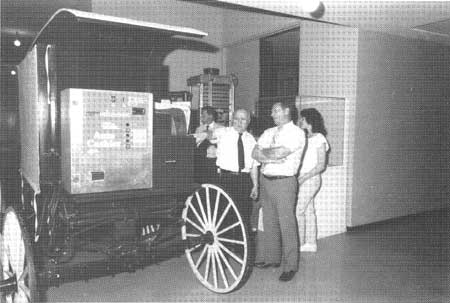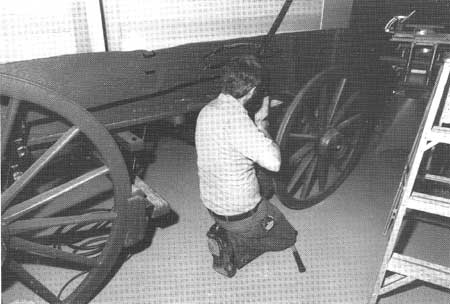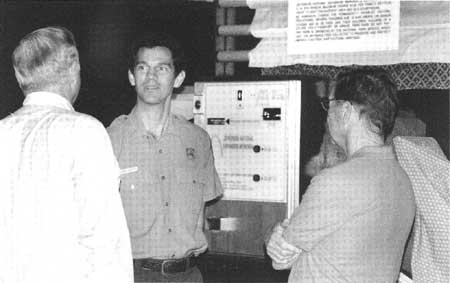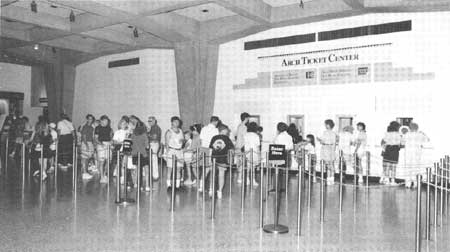|
Jefferson National Expansion
Administrative History |

|
|
Administrative History Bob Moore |

|
| Special wagon with "car wash" type vending machine for fees, May 1988. Pictured left to right are: Superintendent Jerry Schober, Exhibits Curator John Arata, Assistant Superintendent Gary W. Easton, and Museum Aide Cindy Hagley. NPS photo by Al Bilger. |
CHAPTER SEVEN:
Entrance Fee
During the history of Jefferson National Expansion Memorial, the implementation of entrance fees for admission to the Old Courthouse or the Gateway Arch visitor center was urged several times by the Washington and Regional offices. This was especially true in 1982, when shutting down the Old Courthouse was considered by the park administration as a money-saving measure due to lack of funds. [1]
Superintendent Jerry Schober recalled:
The entrance fee idea started under [Midwest Regional Director] Chuck Odegaard, and we were supposed to have a say. I remember it was brought up at a Superintendent's conference here in 1987; we had the deputy director here from Washington, and they were talking about the possibility of putting fees in all the parks. I said to the crowd of superintendents sitting there, "Let me make you guys an offer. Would you get off my back if I told you I'd give you a quarter of a million dollars a year?"
The Deputy Director of the Park Service said "Schober, don't start that crap with us. We're not interested."
But here was where I was coming from. I would have put a surtax on [the Bi-State Development Agency's Arch tram operation] of 25 to 50 cents, and that money would have gone straight into a fund that would be sent to [Washington]. At that time they were having one million people [a year] go to the top of the Arch, and this was how I figured we could work it. Bi-State would have been happy to do it. . . . But they dilly-dallied around [in Washington]. We waited until finally Bi-State came and said "Jerry, it's been a long time since we've had an increase on the admission [on the trams], and we really need it and it's going to be touchy." So, we passed an increase, and I wasn't about to request another one. And as usual the Park Service [then] said "Hey, let's go back to something you brought up about a year ago. We think you ought to put in a surcharge."
By then, Odegaard's gone, and Don Castleberry's in [as Midwest Regional Director]. Don called up, telling me that we'd need to have a fee. And I said "I'm not excited about it, but we could — "
"Well," he said, "It'd be pretty easy, all you'd have to do is just get a ranger there at the door, and they'd sit there in the chair — " I didn't realistically feel that that could work. I wanted [Bi-State] to collect every fee that was charged under the Arch. There's no point in me going to one window for the [tram] ride, going to another place for admission, going to the theater to see the movie, going over here for the wide-screen theater — You would have lines all over that lobby. So I said [to Bi-State], "I want you to get the latest in computers, I'm going to enlarge your space, we're going to put you into a first-class operation. In return, we'll pay your expenses for doing it." [2]
As a result of Regional Director Castleberry's call, a fee for the Gateway Arch complex was again considered, in November 1987, and was reported in The St. Louis Post Dispatch:
A proposal for collecting the fee is due Dec. 4 at the park service's office in Washington, John Townsend said . . . He is a visitor services specialist for the park service's Midwest Regional Office, in Omaha, Neb.
Proposals for new fees are being requested from about 20 of the 339 national parks in the second year of adding fees to national parks, he said.
"We'll do what the regional office wants," said Jerry Schober . . . But he said he rejected the admission fee idea earlier. "We didn't think we were going to have to be doing this."
Schober said he was concerned that the ramps leading to the underground visitors center were too narrow to accommodate booths or turnstiles and allow for quick evacuation in case of an emergency.
Townsend said the appropriations bill that Congress passed for the fiscal year that ended Sept. 30 allowed the park service to increase or add fees to help pay for services — and decrease the deficit.
Fees proposed under the law for the Statue of Liberty and the Independence Hall historic complex in Philadelphia caused a brouhaha last spring, Townsend acknowledged. Congress passed a special bill exempting the Statue of Liberty; the other fees went into effect . . .
Schober said he would prefer to have people pay for use rather than admission. When the idea of an admission fee arose, he said he had suggested an alternative, adding a 25-cent surcharge to the $2.50 charged for the tram ride. With nearly 1 million of the Arch's 2.3 million visitors riding the tram last year, the surcharge would have generated about $250,000, he said.
That idea was rejected, Townsend said, because the federal law allows only federal employees to collect new fees that may be imposed under it. Bi-State employees sell the tickets for the tram ride.
Ray Breun, executive director of the historical association, said he feared an admission fee would discourage visitors.
"It will call for a fundamental change in how the park operates because of the huge number of people who come. You couldn't get them through the door," Breun said. "We'd be the only major museum in town with a charge." John Walsh, president of the St. Louis Convention and Visitors Commission, agreed. [3]
The park administration and local residents were opposed to an entrance fee in light of its practicality and in consideration of the concept of paying to see the visitor center and museum, which had been free since they opened. Superintendent Schober worried that if people were stopped at the entrances and asked for a fee, a significant percentage might decide that going inside the facility was not worth their while. Having seen the outside of the Arch, many visitors might turn back toward their cars, thus not patronizing the film, the museum shop, or the trams. A drop in revenues from these concerns would mean the loss of financing which supported the Gateway Arch Parking Garage, interpretive rangers funded by the Jefferson National Expansion Historical Association, and the possibilities of future projects such as the 70mm theater. [4]
Visitor fees were authorized by Congress in December 1987. Realizing that a fee would eventually be implemented despite his opposition, Superintendent Schober began to pave the legal path toward allowing Bi-State to collect NPS fees. He was aware that an NPS fee collection operation would duplicate work and divert the energies of a staff of up to seven federal employees. This made the collection of the fee by Bi-State, already set up with the facilities and personnel to do so, the most practical solution. Time ran out on this process, however, and the park was forced to begin collecting fees before it was ready to do so. [5] Superintendent Schober recalled:
[I] had in the back of my mind to try to sell [Regional Director Don Castleberry on having Bi-State collect] the fees. So we're on the phone, and he's saying, "I just don't think you should resist it."
"I'm not resisting, Don, but I can't have someone charging at the door. Could you see one ranger standing up there, . . . when people are letting off busloads and everything else, and folks are coming in at 5,000 an hour and that ranger saying "whoaaaa! — Here's some more change." You see, no one knew this operation like we did.
Well, from my conversation I wasn't too convincing to the Regional Director. And he went to the Director of the Park Service and said "May 1 the Arch will be charging." . . . There's one little person he never told — me. March 30, still unknown to me, he [sent] the deputy director of the Region, Bill Schenk, [and three others] from the Region down here to find out how we were going to do this, at which time I told them we were looking into a computer which would take a transaction, and every 19 seconds would spit a ticket out; that would cover the theater, would cover the wide-screen theater when it was completed, and would take one buck for everybody from 16 to 61 . . .
And so, you know, Bill Schenk, who has been very, very helpful to us, says, "OK Schober, we think that's a great idea, but how are you going to do it?"
"What do you mean, how am I going to do it?"
"How are you going to do it by May 1?"
"What is so marvelous about May 1?"
"Well your boss told the Director of the Park Service that you will be doing this by May 1."
"Golly!"
I was fit to be tied. [Assistant Superintendent] Gary [Easton] and I got together and we started talking about how we could quickly put something into effect, without [it] looking so commercial. We had one old wagon, and we bought another one real quick. . . Somebody on our staff [6] thought about those car wash machines, you know when you go up and you either put a code into the machine or quarters in and then the arm goes up and lets you go into the car wash when it's ready? We bought six of those machines, and instead of an arm going up, we connected the wires to a duplicator that spit out tickets. And we put the time and date on the ticket, and it was good for seven days. [This system] gave us fiscal control and it only took quarters, but . . . you could put in four quarters and press a button and shoop! — I mean, as fast as you'd do it it'd spit a ticket out. Now if it was five tickets, you could put a five dollar bill in it, it'd take up your five dollars, press the button for the number, and shoop! it shot out the tickets. But, one little catch. Each one of those machines held a thousand quarters, I think it was. We told the Region that we needed authority to have a . . . $30,000 imprest fund. Oh! They like to have died! [They said] "There's not [an imprest fund] over $500 in the whole Park Service. What, are you all nuts? The government's not going to allow that much money to just lie there as a change fund." We finally got it down to $17,000, and I have to say something for Ed Davis in Washington, he really likes to remind me of that. He OK'd it. So we got $17,000 in quarters, [and] we had to have special [carts] to push them to the machines. We mounted these [ticket machines] on wagons and blended them in [with the ambiance of the visitor center]. [7]
The result was an attractive fee collection area, an easy-to-use system for the visitor, and complete financial accountability for the park, since each machine kept its own internal record of every transaction. On May 26, 1988, at the direction of the Regional and

|
| Maintenance Mechanic Lonnie Collins readying a wagon for the fee collection machines, May 1988. NPS photo by Al Bilger. |
Washington offices of the National Park Service, JEFF began collecting a $1.00 per person entrance fee for visitors between the ages of 17 and 61. Organized school groups and educational outings were exempt from the fee, and individual families were charged a maximum amount of $3.00. Superintendent Schober was quoted in the St. Louis Post-Dispatch: "The legislation calls for fifty percent of the admission fee to be returned to the area where collected. . . . The additional revenue will be used to enhance the park's interpretation program and improve resource protection.'" [8]
The park established a supervisory position and two seasonal fee collector positions to direct the operation and maintain accountability for the fee machines. Park interpreters assisted the seasonal fee collectors near the machines by providing information about the fees to visitors. Both interpreters and fee collectors presented talks before the start of each film in Tucker Theater to explain the purpose of the new entrance fee. [9]
As fee collection began, the park tried a low-key approach, with no signs proclaiming the new policy on the entrance ramps. A blue and white banner reading "Fee Collection Area" was hung over the central fountain in the visitor center lobby, where two wagons, one on the north side and one on the south, held three ticket machines. Park interpreters were stationed at the machines to provide information and assistance, but collection was based on the honor system. By the end of the first week, daily collections were running about $200 per day, in a season with daily attendance of 15,000 people. This method of fee collection was simply not practical at a park as busy as JEFF. [10] As JEFF interpreter Eleanor Hall recalled:
There were two wagons, one a farmers wagon, and the other a peddler's wagon. Each wagon was staffed at all times by an interpreter, one facing the north entrance and another the south. At first, one hour tours of duty were tried for these spots, but it was a difficult, impossible job, and it was bad for morale. You had to constantly try to get people's attention by saying "Please pay entrance fee here," or something to that effect. On busy summer days you couldn't be heard above the din. Visitors, unused to paying a fee or unaware of your purpose in standing there by the wagons, generally ignored you. Some thought it might be a voluntary donation, while others objected to paying and simply refused to do so. Often, when honest folks had paid their admission and saw others streaming right by the machines without paying, they demanded their money back. Some people thought the machines were for making change. [11]
Many visitors approached the fee wagons because they thought them to be museum exhibits, others in the belief that the tickets were for the ride to the top of the Arch. Friction developed between the NPS and Bi-State Development Agency staffs because many visitors attempted to use their entrance fee tickets to board the trams to the top. [12]
The honor system was not successful, nor had Superintendent Schober anticipated that it would be. By the end of the first year, approximately $120,000 had been collected, despite attendance figures of 2.5 million people. By 1989, park management was able to arrange for the Bi-State Development Agency to assume the collection of NPS entrance fees. In February 1989, Bi-State began operating the centralized revenue collection and ticketing system in the visitor center, handling tram fees, JNEHA's movie fees, and the NPS entrance fee. A cooperative agreement was approved by the solicitor's office and Bi-State's legal counsel, which formalized the process and provided a prorated payment to Bi-State for NPS portions of the total cost. In 1989, the park collected six times the amount of money received in 1988. The successful plan administered by Bi-State mirrored the original Schober proposal for fee collection. [13]

|
| Park Ranger George Baitinger tells visitors about the new fee program at JEFF. NPS photo by Al Bilger. |
By 1990 the centralized revenue/ticketing area constructed for Bi-State was fully automated, which greatly expedited the purchase of tickets, the payment of the NPS entrance fee, and reservations. It was estimated that each transaction was completed in less than 20 seconds. [14] The integrity of the site was preserved by the implementation of the Bi-State fee collection system, although some confusion was caused by the process. Many visitors did not realize that they were paying an entrance fee at the ticket window. The park continued the theater talks, even after the establishment of the centralized ticket system, to explain to the public the purpose and necessity of an entrance fee. The issues of safety, park revenue, efficient utilization of park employees, and the enjoyment of the visitor were all addressed with the assumption by Bi-State of fee collection duties, a unique solution to a potentially severe management problem.

|
| Fee collection area run by Bi-State Development Agency, Gateway Arch visitor center. NPS photo by Al Bilger. |
| <<< Previous | <<< Contents >>> | Next >>> |
jeff/adhi/adhi2-7.htm
Last Updated: 15-Jan-2004